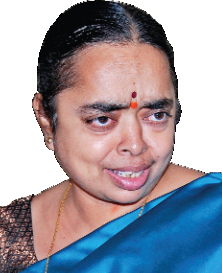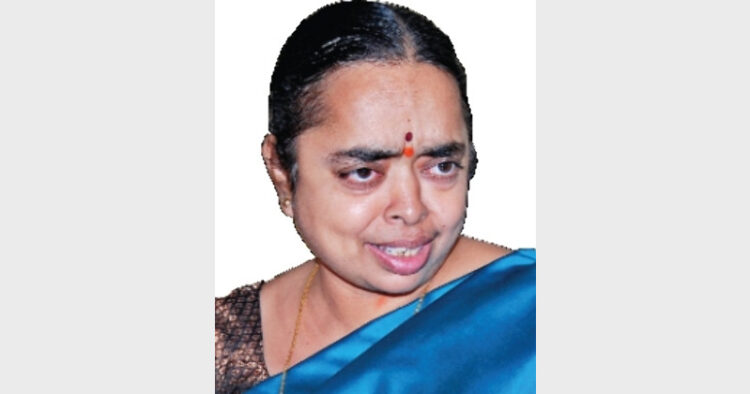 During the last eight decades the Rashtra Sevika Samiti has been successful in motivating the women to come out from their houses and while discharging their duty towards their families actively join hands in social transformation and nation building. Organiser Senior Correspondent Pramod Kumar spoke to Pramukh Karyavahika of Rashtra Sevika Samiti Sushri Annadanam Sitha, who is affectionately called Sitaakka among billions of Sevikas all over
During the last eight decades the Rashtra Sevika Samiti has been successful in motivating the women to come out from their houses and while discharging their duty towards their families actively join hands in social transformation and nation building. Organiser Senior Correspondent Pramod Kumar spoke to Pramukh Karyavahika of Rashtra Sevika Samiti Sushri Annadanam Sitha, who is affectionately called Sitaakka among billions of Sevikas all over
the country, to know the 80 years journey of the country’s largest women organisation. Excerpts:
How do you look at the 80 years’ journey of Rashtra Sevika Samiti?
It is full of achievements and has been successful in reshaping the vision of women towards the society and the nation. In 1936, when the Samiti was founded, the participation of women was very limited in social activities. But now it has increased manifold in all spheres of life. In the beginning the Samiti’s work was limited to Maharashtra only, but now it has spread all over Bharat creating an army of dedicated women who are actively joining hands in nation building.
Do you feel the objectives for which the Samiti was formed 80 years back by Mausiji Kelkar have been achieved?
Yes. Right from the beginning, the Samiti is committed to preservation and promotion of the Bharatiya values, especially the moral values and family system. Now apart from Samiti, many social activists and scientists too have reached the conclusion that family is the bases of our social and moral structures. In Samiti Prarthana, we daily say Dhanya Janani Bhave Meti (fulfillment of womenhood is in being a good mother only). Now many philosophers also admit that it is the ultimate goal of motherhood or a woman’s life.
What are the major milestones achieved by the Samiti in eight decades?
In 1936, the Samiti’s focus was on self-defence and organisation of women. Vandaniya Mausiji’s vision about Samiti and women of Bharat was very clear right from the day one. In an Akhil Bharatiya Sammelan held at Mumbai in 1953 she proposed to start a hostel for the girl students who want to study outside their villages or towns. And she started a hostel for them. At the same time in 1953, after discussion with some doctors and yoga therapists, she started a Yoga Kendra for women. She stressed that practicing yoga is good for health of women. Some Self-Help Groups (SHGs) were also started for self-reliance of women. They were initial milestones in the Samiti’s work.
But in 1953, Mausiji visualised other ways also where women could work. Now the entire society is following the same path. After that the Samiti started activities for Kishori Vikas and Bal Vikas. Apart from it, the Samiti workers actively participated in nationalist movements like Ekatmata Yatras, Sri Ramjanmabhoomi Movement, Save Amarnath Yatra, Save Ramsethu Movement, etc. Prior to that, they did tremendous work against Emergency. All these activities proved helpful in expanding the Samiti’s work to every nook and corner of the country. In 1996, we had an Akhil Bharatiya Sammelan in Delhi. In 2003-04, one year before Mausiji’s birth centenary year observed in 2005, Vandaniya Pramilatai Medhe, the then Sah Pramukh Sanchalika, toured all over the country with an exhibition of Mausiji. The exhibition toured through 108 places and around 2,20,000 people participated. The people were very much interested to know about Mausiji and the Samiti. During the Sardhshati of Swami Vivekananda we organised 1690 Kishori Bal Vikas Shivirs all over Bharat as well as 178 intellectual women meets under the banner of Samvardhini. In our Parivar Kshetra, whenever there is programme at national level the Samiti workers participate with full enthusiasm.
Any special programmes on the occasion of 80 years of Samiti?
In order to celebrate 80 years, we conducted 287 Taruni Sammelans all over the country. Over 85,000 youngsters between the age group of 16 to 45 years participated in those programmes. Apart from it, 2,500 intellectual women from different sections of the society participated in these programmes as part of the Reception Committees. All these are milestones in the journey of the Samiti.
What is the present status of Samiti’s work in the country?
We have work in all the states. In Mizoram, the Samiti was first to step in among all our Parivar organisations through a hostel started by our former hostel Sevika. At the moment we run about 400 sewa projects, which include 22 hostels, 180 SHGs, Samaskar Kendras, etc.
What is the status of Samiti’s work in rural areas?
In some states we have work at village level. In Assam Kshetra, we have shakhas in villages also. Due to some social circumstances like the veil system in some states like Uttar Pradesh, Bihar, Rajasthan, etc people do not allow women to come out of the houses. For them, we conduct some havan and bhajan programmes. In this way, we have indirect presence in a large number of villages. However, at some places where the Pravasi Karyakartas visit occasionally we have Shakhas at village level also. In 2005, we started a special programme, Gramin Mahila Vikas Programme for village women. We have selected 108 villages and so far we have reached up to 58 of them through service activities.
What is Samiti’s stand on entry of women in Sabrimala or Shani temple?
There is science in culture also. Some temples have their own rules and regulations. The Samiti does not want to interfere in those rules. That is not our work.
Any specific plan to expand the organisational work in coming days?
After Taruni Sammelans, we have planned some activities to expand the work. The women between the age group of 16 to 45 are being focussed through these Sammelans. Both the shakhas and service activities will be expanded. Even through “Join RSS” programme of Rashtriya Swayamsevak Sangh so many women expressed their will to work with us. We have to give work to them. So, we have planned various outreach programmes for next ten years. We are also planning to start Parivar Prabodhan activities.
What is the status of work outside Bharat?
The Samiti does not operate outside Bharat. But there are some organisations of Hindu women which draw inspiration from the Samiti and work independently in the name of Hindu Sevika Samiti. There is work in eight countries including UK, Sri Lanka, Kenya, etc in the name of Hindu Sevika Samiti. The Sevikas work together with Swayamsevaks under the banner of Hindu Swayamsevak Sangh (HSS) which is called as Parivar Shakha in some countries like the US, Australia, New Zealand, Canada, etc.
Now there is a favourable government at the Centre. Does it help the Samiti in any way to expand the work?
It makes no difference for us. We are working for our own goal i.e. Tejasvi Hindu Rashtra or Glorious Bharat. We are not working just for women issues. All other women organisations are working just for women issues, but despite being the women’s organisation we work for the entire nation. As people say about democracy—of the people, by the people for the people. We say the Samiti is ‘of the women, by the women for the nation’.
You say the Samiti works for Bharatiya values. But the influence of western culture seems to be dominating in the country?
It is not dominating. Physically some youngsters seem to be imitating the West. When we see 85,000 young girls attending our Taruni Sammelans, it shows that they are still close to the Bharatiya values and they think about the nation. So many youngsters joined the discussions on Bharat Bhagya Vidhata expressing innovative ideas. They are for maintaining balance in job and
family. Previously, the women preferred jobs with 10 to 5 timings. Since it is difficult for some women to manage with it, they now prefer jobs with flexible timings. It shows they are serious to give more time to their families and children. This is not the influence of the West. They may be seen imitating the West in dress, but internally their soul is with Bharat only. Apart from Taruni Sammelans, a good number of youngsters are joining the Samiti’s Shiksha Vargas every year. About 9,000 young girls attend our 15-day annual training camps on their own expenses.













Comments